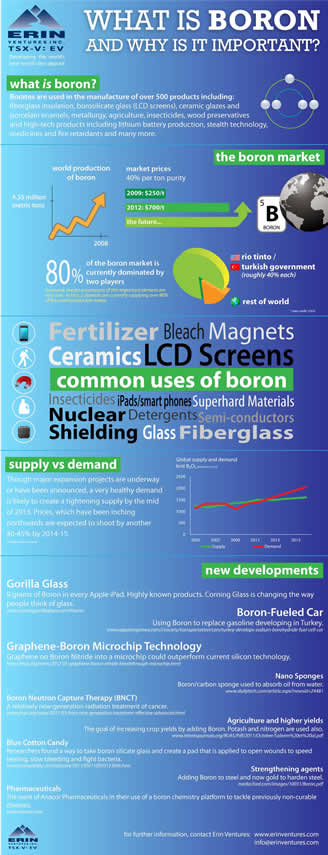
By clicking on this link you will be leaving the Erin Ventures website and entering the website of a third party. Erin Ventures has no control over this third party website and accepts no responsibility for either its content or its security. Erin Ventures does not adopt, confirm or endorse any information that may be contained on this website.
External links either open a new browser window or prompt you to view or save a PDF file on your computer. Click [X] to close these new windows to return to this page on the EV site.
(or press ESC or click outside this window)
This release contains forward looking statements. The words "believe," "expect," "feel," "plan," "anticipate," "project," "could," "should" and other similar expressions generally identify forward-looking statements. Readers are cautioned not to place undue reliance on these forward-looking statements. These forward-looking statements are subject to a number of risks and uncertainties including, without limitation, variations in estimated costs, the failure to discover or recover economic grades of minerals, and the inability to raise the funds necessary, changes in external market factors including commodity prices, and other risks and uncertainties. Actual results could differ materially from the results referred to in the forward-looking statements.
(or press ESC or click outside this window)
Properties: Piskanja

Piskanja is located in a historical mining region that has good infrastructure for mining including roads, rail, electric power, experienced miners, etc., 250 km south of Belgrade, Serbia by good paved roads. Lithology at Piskanja is typical of sedimentary basins, (primarily shales, marls and limestone) with two primary gently undulating borate beds. Mineralization is primarily dense, compact colemanite with some ulexite.
Erin Ventures was granted an exploration license with the sole right to apply for an exploitation (mining) license for the Piskanja boron deposit located in Serbia in the third quarter of 2010.
Erin management is actively engaged in the due diligence process with several potential strategic partners regarding the development and exploitation of its Piskanja boron project in Serbia.
What is Boron?
Articles
High-tech and low tech, boron's on the rise. But can you get access? Read full article - disclaimer Boron: From Fishing Rods To Flares (PDF, 652k) - Hard Assets Investor
Further reading - disclaimer Marching Ahead - Borates Look to High-priced Future – Asian Ceramics.
Introduction
It is difficult to comprehend the variety of uses of boron in construction, manufacturing, medicine, science, microelectronics, pharmaceuticals, telecommunications, space travel, communication satellites, specialty metals, battery technology and more! We could not survive without the element boron. It is found all around us and we are in constant contact with this vital element – even though we are, for the most part, not aware of it. Interestingly, economic occurrences of Boron are quite rare and large economic deposits exist in only a few places.
Some common applications of boron include glass production, insulation, fertilizer, silicon, metallurgy, LCD screens, stealth technology, sports equipment, nuclear reactors and waste storage, lithium batteries, computers, heat shields and medicines. Boron can also be found in automotive products like motor oil, brake fluid, steering fluid and antifreeze.
The number of items that contain boron in homes is surprising. Roofing materials, wallboard, paint, fiberglass insulation and cellulose insulation all contain boron. When used as a treatment for construction materials such as wood, plastic, bricks, pipes and wires, boron helps to protect from mold, fungus and insects. Boron is found in the ceramic tiles on the floors, in the porcelain enamel used on your sink, refrigerators, pots and pans. Boron is also in heat resistant cookware, crystal glass and dishwasher detergent. Boron is also found in soap, shampoo, creams, lotions, makeup, shaving cream, lens solution, hair products (dye, straighteners, perms etc.) and even tooth and denture products. Sheets, bed coverings and clothing contain boron that improves fibre performance. Boron is also used in detergents, laundry boosters and bleaches.
All plant life requires boron to grow. Boron is key to the flowering, pollen, seed and fruit development and germination itself. It also plays a major part in the production of sugar and carbohydrates within leaves and roots. Fertilizers also contain boron. It would not be possible to grow many crops, especially in areas where the natural occurrence of boron is low, without the addition of boron.
Boron is a critically important industrial mineral. World production of boron minerals reached an estimated 4.35 million metric tons in 2010.

Consumption of borates used in high-technical applications is expected to increase by 10% in North America and 13% in Europe by 2012. China is the largest consumer of boron, where consumption has risen by 15 percent per year from 2000 to 2010.
Borate minerals and refined borate products are used extensively worldwide in the manufacture of vitreous products such as fiberglass insulation, textile fiberglass, borosilicate glass (e.g. LCD screens), ceramic glazes and porcelain enamels. These applications account for approximately 60 per cent of borate consumption, with detergents, fire retardants, metallurgy, agriculture, insecticides, wood preservatives and specialty products accounting for the remainder.
Source: US Geological Survey, Report on Boron - 2010 (with 2011 update).
Market prices reflect the relative scarcity of borates with prices averaging: US$500-$700/tonne for colemanite concentrate (40% B2O3); $500-$700/tonne for ulexite (40% B2O3); $620-$900/tonne for boric acid.

Source Industrial Minerals Online. June 2011
Erin Ventures News
Click on a link below to view our news.» Latest News (2018)
» 2017 News Archive
» 2016 News Archive
» 2015 News Archive
» 2014 News Archive
» 2013 News Archive
» 2012 News Archive
» 2011 News Archive
» 2010 News Archive
» 2009 News Archive
» Complete Filing List disclaimer







